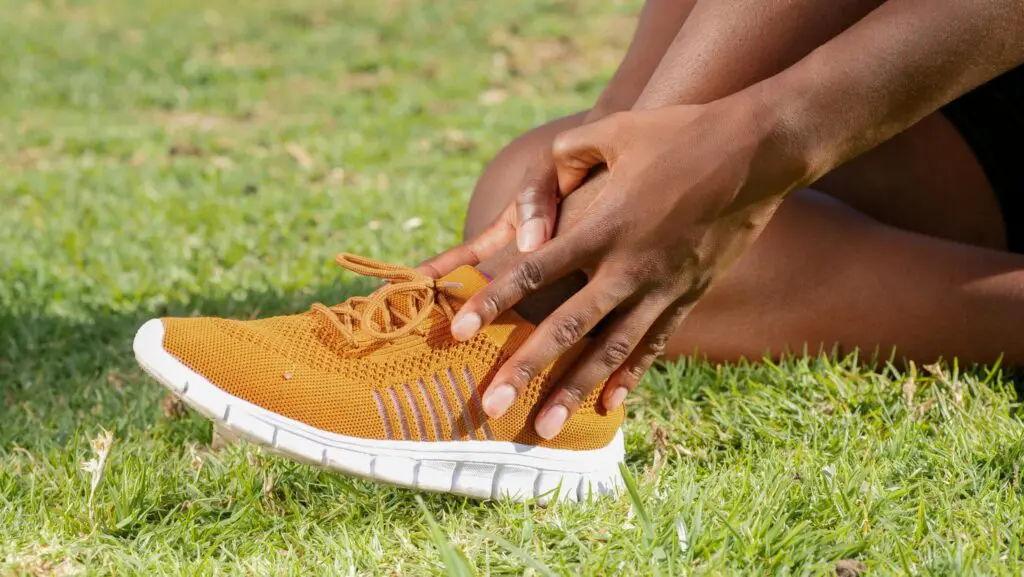The human foot is a complex set of muscles, bones, tendons, ligaments, and joints that must work together to function properly. Pain on the top of the foot is typically the result of overexertion, but it can also be caused by injury, chronic conditions, or even wearing shoes that are too tight. Let’s explore the potential causes of pain on the top of the foot.
Common Culprits: Overuse and Injury
Overuse through running, jumping, or kicking is the most common cause of top-of-foot pain, closely followed by injury.
Stress Fractures: Microscopic Cracks From Repetitive Stress
If you have ever pushed yourself to run through the pain or to keep working out despite discomfort, you may have developed stress fractures. These microscopic cracks occur most often in the bones of the lower legs and feet. Stress fractures in the foot can cause pain on top of the foot and swelling across the top or around the outside of the ankle. The pain worsens when the foot bears weight, and while it may go away with rest, the pain returns with activity. Treatment typically includes RICE (rest, ice, compression, elevation) and modifying your activities until it heals. A brace or cast may be recommended for the six- to eight-week healing period.
Extensor Tendonitis: Inflammation of the Tendons Lifting Your Toes
Extensor tendonitis, or inflammation of the tendons that lift your toes, is another potential cause of pain on top of the foot. Symptoms include pain, particularly when lifting the toes, swelling, and warmth or redness around the tendon. RICE and nonsteroidal anti-inflammatory drugs (NSAIDs) are the best treatment. Consider corticosteroid injections, physical therapy, or regenerative foot therapy if your symptoms persist beyond a couple of weeks.
Other Injuries: Sprains, Strains, and Contusions From Falls or Impacts
Additional injuries that can cause pain on the top of the foot include overstretching or tearing the ligaments that connect the bones of the foot. In addition to a sprain, a strain of the tendons that attach the muscles to the bone also causes pain and swelling, as does a direct impact that causes bruising or contusion. RICE, NSAIDs, and physical therapy are the best remedies.
Underlying Conditions: Beyond Simple Wear and Tear
Pain on top of the foot is most often related to overuse of the muscles, tendons, or ligaments. However, systemic conditions can also cause pain in the same region.
Arthritis: Degenerative Joint Disease Affecting the Midfoot
Both rheumatoid arthritis (RA) and osteoarthritis (OA) can cause pain across the top of the feet. RA can cause swelling, pain, and, over time, joint deformity. The degeneration of OA commonly leads to bone spurs or bony growths that may irritate tendons, ligaments, or nerves, causing pain. Anti-inflammatory medications, physical therapy, or regenerative arthritis treatments can treat the pain. In severe cases, disease-modifying antirheumatic drugs (DMARDs) may be recommended for RA, while corticosteroid injections and possibly surgery might be used for OA. Those suffering from either form of arthritis can benefit from weight management, physical therapy, and regenerative medicine.
Gout: Uric Acid Crystals Building Up in Joints, Causing Sudden Pain and Inflammation
Gout is a specific form of arthritis resulting from uric acid crystallizing and building up on the joint. The crystals’ sharp edges dig into and inflame the joint’s soft tissues, causing severe pain, redness, swelling, and heat. Gout most commonly forms in the big toe but can occur in any joint, including the small joints across the top of the foot. NSAIDs and RICE are the first-line treatments for gout in the foot. Dietary changes, weight management, and improved hydration can prevent attacks of gout. Corticosteroids may be used in severe cases.
Peripheral Neuropathy: Nerve Damage Causing Pain, Numbness, Tingling, and Weakness.
Peripheral neuropathy is damage affecting the nerves of your body, causing stabbing, burning, or tingling pain where the damage occurs. When neuropathy causes pain in the top of the foot, it also causes difficulty walking. Peripheral neuropathy has multiple potential causes, including:
Traumatic injury
Genetic conditions
Infections
Metabolic disorders
Exposure to toxins
Diabetes
Vitamin B1, B3, B6, B12, or E deficiency
In addition to using RICE and NSAIDs, the underlying conditions causing neuropathy must be resolved to alleviate the pain. Often, neuropathic pain requires medical support for stronger pain management.
When To Seek Help: Recognizing Serious Issues
While you don’t want to run to the doctor for every minor ache and pain, seeking medical attention is critical in some cases.
Red Flags: Severe Pain, Swelling, Bruising, Inability To Bear Weight, Deformity
After a hard run, a tough tennis match, or tending the garden, you might experience pain on the top of your foot. Taking it easy for a while may be all you need. Try RICE and NSAIDs at home.
However, if any of these red flags occur, seek professional evaluation:
- Severe pain that makes walking difficult
- Inability to support your weight on the foot
- Severe swelling that persists after ice and elevating the foot
- Bruising or discoloration
- The foot seems cold or warm
- Any deformity to the foot
- Fever or chills
If you experience any of these symptoms, it’s time to seek medical attention.
Importance of Early Diagnosis: Prompt Treatment Can Prevent Complications
Getting medical attention for severe symptoms accompanying pain on the top of the foot means that you won’t risk compounding a minor injury with far more serious damage. When sidelined by pain, you need to treat and resolve the pain’s cause.
Seeking Professional Evaluation: Doctors Can Diagnose The Cause And Recommend Treatment
Your doctor can diagnose the specific cause of your pain and recommend targeted pain relief measures, exercises, stretches, and physical therapy that will improve your condition without risking further damage.

Regenerative Therapies Can Relieve Pain
QC Kinetix provides regenerative therapies that leverage the body’s innate healing mechanisms to resolve your pain at its source. We provide information about this exciting field of medicine in our regenerative medicine blog and our frequently asked questions — but the best way to learn what QC Kinetix can do for your specific condition is to schedule a free consultation at one of our regenerative medicine centers.
Learn what to expect when you visit QC Kinetix, and check out our patients’ QC Kinetix reviews.
We look forward to helping you find pain relief, improved function, and greater range of motion. Please contact us with any questions.


